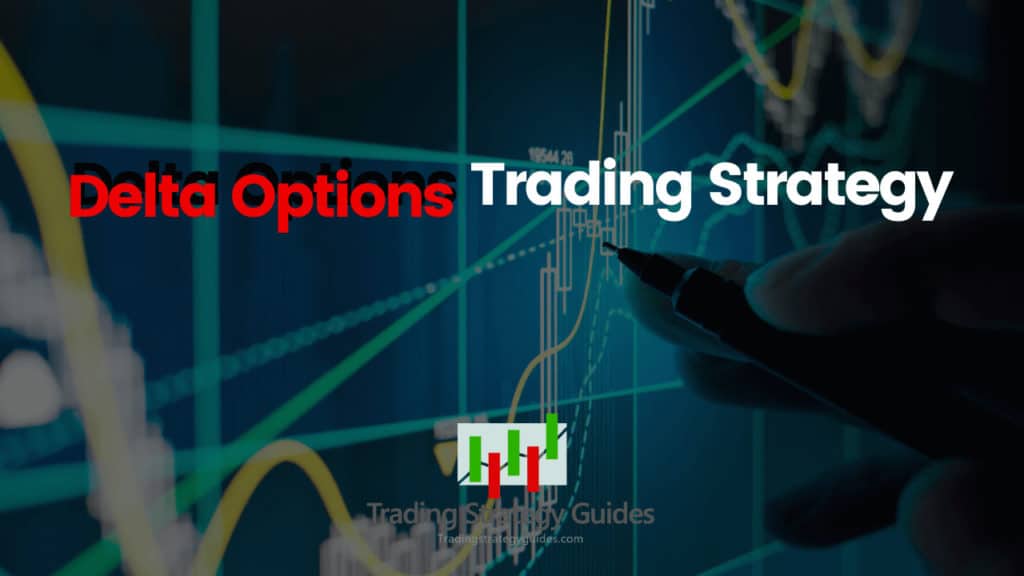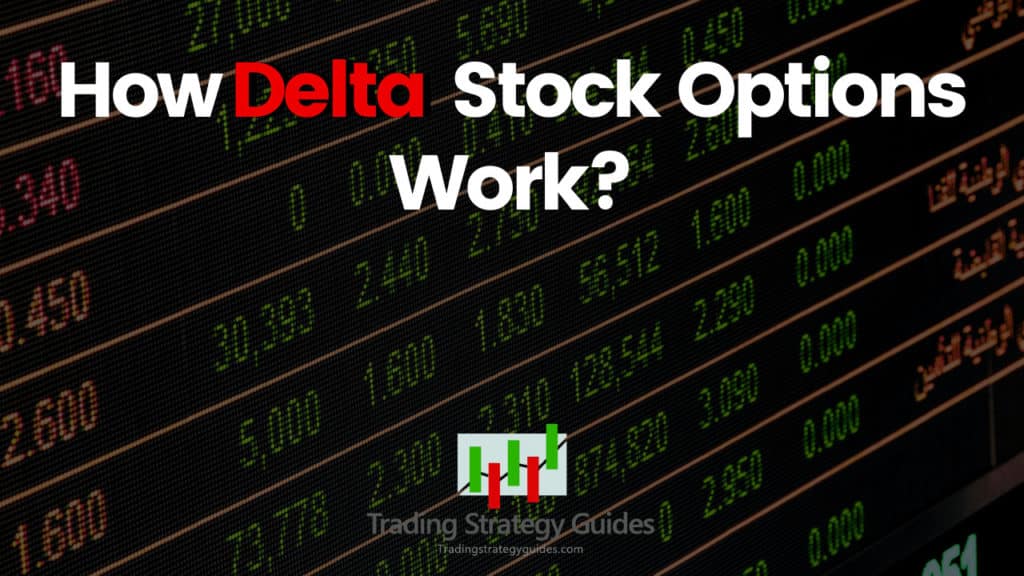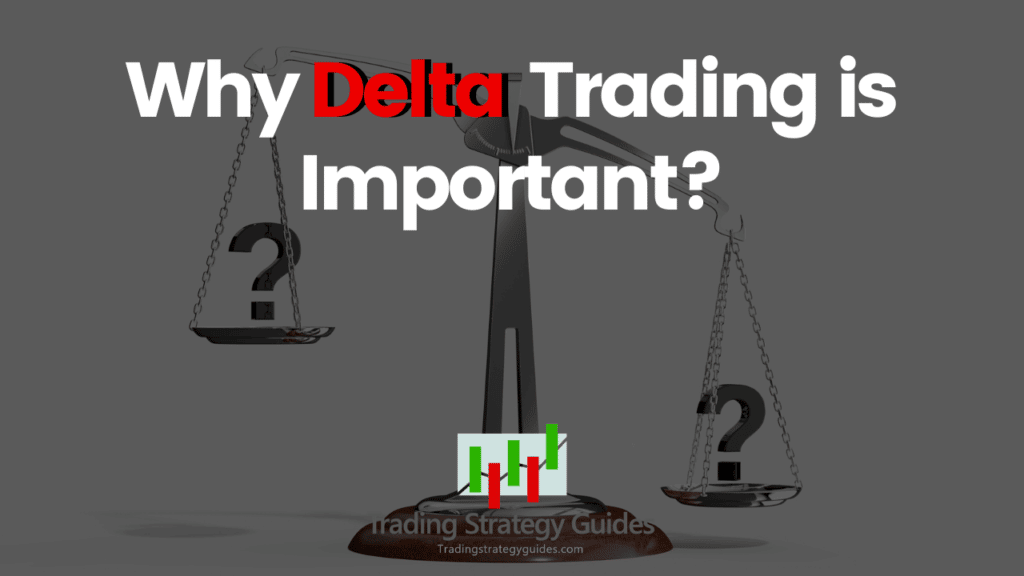Delta Options Trading Strategy

The delta options trading strategy is a suitable strategy for options trading with a small account balance. We promise that after you go through this options trading guide you’ll understand completely what is delta options trading and why this is key to options profitability. You will also learn a useful way to use delta trading to trade low volatility.
If this is your first time on our website, our team at Trading Strategy Guides welcomes you. Make sure you hit the subscribe button, so you get your Free Trading Strategy every week directly into your email box.
Delta, Gamma, Theta and Vega are all Greek words that may seem confusing on the outside, but we promise that at the end of this options guide you’ll understand completely how delta in trading works.
If you have a limited capital to invest in stocks you have a limited range of trading strategies to use and make big profits. You can’t buy a lot of stocks because your capital is too small.
Delta trading lets you adjust your account so you can position yourself to make big profits in the stock market with small capital. For this, you need to know how to manage the delta.
If you know nothing about delta we’re going to cover everything you need to know plus we’re going to show you how option delta calculation work so you can know at any moment in time how much your option value is worth.
Understanding what is delta in trading can assist us to better pick our strike prices and why delta stock options are key when you have a small trading account.
Let’s begin…
What is Delta Options Trading
Delta is one of the four options Greeks. And the option Greeks can help us analyze how our options trades are expected to perform relative to changes in specific things with the underlying instrument. The “Greeks” can be used for many different trading strategies and have many different applications.
So, what does delta mean in options?
The options Greek delta is the directional risk measurement of an option. Delta essentially measures how much your option will increase or decrease in value based on the underlying price change of the stock. And, that’s the reason why delta investments are so important.
For understanding delta in options, you can view it as a sensitive barometer that tells us how sensitive the option’s price is relative to the stock price changes. So, the delta is telling us the expected price change of that option relative to a one-dollar movement in the stock price.
Let’s take a hypothetical options trading example.
For a delta of 0.70 or 70%, it signals that the option will move equal to 70% of the underlying stock’s price change.
If the stock price goes up by $1, we should see an equivalent 70 cents rise in the option premium. On the other hand, if the stock price fell by $1, the option should decrease by 70 cents.
This seems easy. But as our friend Trader Mike explains, delta trading strategies can often be very nuanced.
Now, moving forward, let’s learn how to calculate the delta of an option for both single-leg options trading strategies and multi-leg options strategy.
See below the option delta calculation.
How to Calculate Delta of an Option
The options delta formula is a simple multiplication equation between the delta and the number of contracts purchased or sold.
Position Delta = Delta x 100 x Number of contracts
Here’s a call option delta example.
We assume you own 5 contracts of Facebook calls, with a delta of 0.65.
The delta option calculation gives you a result of $325.
Position Delta = 0.65 x 100 x 5 = 325
This means that if the stock price goes up by $1, the option position will increase by $325.
So, how do we calculate the expected option value using delta?
For this one, we apply the following option delta calculation:
$1 increase in Stock Price = Current Option Price + Delta
So for our example, if we assume the current option price of $3, a one-dollar increase in the stock price means that the option is expected to be worth $3 + 0.65 = $3.65. This is just an estimated new options price.
When we have a multi-leg options strategy the option delta calculation involves calculating the position delta for each leg individually and then simply sum up the results.
Let’s consider we have a simple long call spread with two legs.
For example, ABC stock is trading at $100 and we went long 10 contracts at 95 strike price and short 10 contracts at 110 strike price. Both options having the same expiration date. The delta for these two legs is 0.50 for the long options and -0.30 for the short options.
The positional option delta calculation for the first leg is 0.50 x 100 x 10 = $500 and respectively for the second leg -0.30 x 100 x 10 = -$300.
When we sum up the two results, we get the total option delta calculation $500 + (-$300) = $200.
However, to fully understand delta stock trading you need to also understand how delta finances work?
Let’s look at some examples and see how delta options trading works.
See below:
How do Delta Stock Options Work?
In general, the delta price will increase or decrease depending on how in-the-money or out-of-the-money your option becomes.
As an example:
Let’s assume the Apple stock is trading at $300 per share and you had a $310 out-of-the-money call option with an expiration date 4 months from now. That option might have a delta of 0.40 or 40%.
We’re also going to assume the Apple option was priced at $5.00, which is equivalent to $500.
To go along with our stock options example, we’re going to assume Apple stock increased by $10.
Let’s see how this increase in the stock price will affect our stock options delta.
Our out-of-the-money OTM call option with a delta of 40% would increase by $4.00, which is equivalent to $400.
Note* as the delta option goes further in the money your delta will increase up to 100%. On the same note, if the stock option gets further out-of-the-money your delta will decrease.
Let’s now resume our train of thoughts with the above stock options example.
So, now our Apple stock option is at the money. But, our delta might also increase from 40% to 65%.
In this case, if Apple stock were to increase by another $10, our stock option will now increase by 65% which is equivalent to $650.
As you can tell, your delta increases as the stock price go up and the delta will decrease as the stock price moves down.
Now, there is one critical thing you need to pay attention is that stock options price moves totally different than the underlying stock market price.
See below:
Why Delta Trading is Important?
In previous posts, we’ve just discussed just how beneficial options trading can be. By using the Greeks, we are able to add another layer of analysis that can help us make smarter trading decisions.
Let’s assume a hypothetical example where the underlying stock price goes down. Subsequently, the option price will go down as well. Not only the option price is decreasing, but the delta value is also going down.
Now, the harmful effect is that in some instances, when the stock price reverses back to where it was when you purchase the option, your option value may not get back to where it was.
How can we explain this option phenomenon?
The option value on the way down was decreasing at a higher percentage because the delta was higher. But, when the stock price went back up, your option value was increasing at a smaller percentage because the delta now was lower.
So, you may be right on the stock price direction, but you can be wrong on the option trade.
This is why it’s important to figure out when it’s best to buy an in-the-money option, at the money option or out-of-the-money option.
Don’t just buy OTM options because they are inexpensive. The out-of-the-money options can be good when the stock price is surging with strong prevailing momentum. However, if the stock price is lacking the momentum, the out-of-the-money option, which has a small delta, is barely going to move. Subsequently, you’re also going to fight the time decay.
On the other hand, if you buy ITM options, even if the stock price has a small price movement your option can rapidly become profitable.
Now you might be wondering:
How exactly can you profit from managing the stock options delta?
With delta neutral positions you can minimize the risk and at the same time protect your small account balance.
Sounds good?
Then let’s get started…
Delta Options Trading Strategy
In this section, you’re going to learn a delta options trading strategy, namely the delta-neutral strategy.
You might be asking yourself:
What is delta neutral trading?
In finance, delta neutral is the total position in a given stock were the sum of the deltas of Puts, Calls, and stock is close to or equal to zero. The main advantage that comes with using delta neutral trading is that you can profit from the time decay of options.
So, how to construct a delta neutral position?
For this purpose, we’re going to consider a hypothetical example.
We assume we have the following two options:
- April 60 Calls = 3.0 with a delta = 70
- April 50 Puts = 1.20 with a delta = -35
To construct a delta neutral position, we need to form a ratio of the two deltas: 70/35 = 2.
This means that we have to buy 2 Puts contracts for every Call contract.
For example, if we buy 10 Calls we need to buy 20 Puts to form a delta neutral position. If we want to write options, we can sell 10 Calls and 20 Puts.
Alternatively, we can also have any combination by adjusting the position with the stock.
To understand this more advanced concept, let’s look at the same example.
Instead of neutralizing our positions by adjusting the number of options contracts, we’re going to either buy or sell the underlying stock shares.
If we only buy 10 Calls and let’s say 15 Puts we’re left with the following deltas.
We apply the option delta calculation and have the following deltas:
- 70 x 100 x 10 = $700
- -0.35 x 100 x 15 = -$525
If we sum up the two deltas we have $700 – $525 = $175.
We didn’t manage to bring our delta close to zero.
So, what we can do is to sell 175 shares of the underlying stock to construct a delta market neutral position. Balancing the positive and negative deltas is an essential risk management tool that can help you bring your options trading game to the next level.
Final Words – Delta Trading
In summary, delta trading can really increase the probability of success with options. Before you engage with these concepts make sure you understand the stock options delta and how the option delta calculation really works.
By using the delta options trading strategy you’re able to hedge-out the delta or the directionality of the options. The main risk exposure to the delta neutral strategy is volatility. In this case, you’re trading volatility and make money regardless of the market direction.
If you’re right about the correct level of volatility and how that differs from the implied volatility in the price of an option you can make big profits even with a small trading account. Using volatility indicators, such as the Average True Range (ATR) can help make it much easier to determine when these strategies will be most effective.
Thank you for reading!
Feel free to leave any comments below, we do read them all and will respond.
Also, please give this strategy a 5 star if you enjoyed it!
[ratings]













This seemingly simple strategy ….would it work in real market …..how about the slippage
Sple